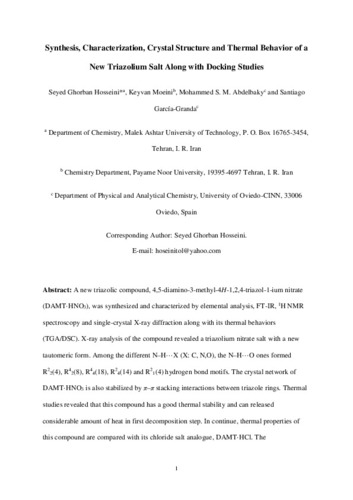Synthesis, characterization, crystal structure and thermal behavior of a new triazolium salt along with docking studies
Autor(es) y otros:
Palabra(s) clave:
triazole
X-ray crystal structure
docking studies
TGA
DSC
DFT
Fecha de publicación:
Versión del editor:
Citación:
Descripción física:
Resumen:
A new triazolic compound, 4,5-diamino-3-methyl-4H-1,2,4-triazol-1-ium nitrate (DAMT·HNO3), was synthesized and characterized by elemental analysis, FT-IR, 1H NMR spectroscopy and single-crystal X-ray diffraction along with its thermal behaviors (TGA/DSC). X-ray analysis of the compound revealed a triazolium nitrate salt with a new tautomeric form. Among the different N–H···X (X: C, N,O), the N–H···O ones formed R22(4), R42(8), R44(18), R24(14) and R21(4) hydrogen bond motifs. The crystal network of DAMT·HNO3 is also stabilized by π–π stacking interactions between triazole rings. Thermal studies revealed that this compound has a good thermal stability and can released considerable amount of heat in first decomposition step. In continue, thermal properties of this compound are compared with its chloride salt analogue, DAMT·HCl. The thermodynamic stability of DAMT·HNO3 was studied by DFT calculations and compared with DAMT·HCl and DAMT. The ability of these compounds to interact with DNA molecule was investigated by docking studies.
A new triazolic compound, 4,5-diamino-3-methyl-4H-1,2,4-triazol-1-ium nitrate (DAMT·HNO3), was synthesized and characterized by elemental analysis, FT-IR, 1H NMR spectroscopy and single-crystal X-ray diffraction along with its thermal behaviors (TGA/DSC). X-ray analysis of the compound revealed a triazolium nitrate salt with a new tautomeric form. Among the different N–H···X (X: C, N,O), the N–H···O ones formed R22(4), R42(8), R44(18), R24(14) and R21(4) hydrogen bond motifs. The crystal network of DAMT·HNO3 is also stabilized by π–π stacking interactions between triazole rings. Thermal studies revealed that this compound has a good thermal stability and can released considerable amount of heat in first decomposition step. In continue, thermal properties of this compound are compared with its chloride salt analogue, DAMT·HCl. The thermodynamic stability of DAMT·HNO3 was studied by DFT calculations and compared with DAMT·HCl and DAMT. The ability of these compounds to interact with DNA molecule was investigated by docking studies.
Patrocinado por:
We acknowledge the financial support from Spanish Ministerio de Economía y Competitividad (MAT2016-78155-C2-1-R).
Colecciones
- Artículos [37321]
- Investigaciones y Documentos OpenAIRE [8282]
- Química Física y Analítica [633]
Ficheros en el ítem





